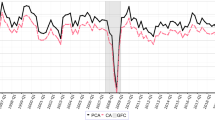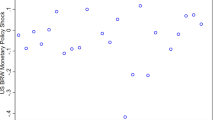Abstract
This paper attempts to access whether Greece’s low openness is a reflection of its low trade integration primarily as a result of the country’s relatively poor goods export performance. The analysis estimates potential trade flows for Greece through a gravity model using a panel of cross-country data, which cover bilateral trade flows concerning the EU member states. These flows are then derived by applying the estimated parameters to the Greek economy. The results show that actual Greek exports fall short of potential ones, while the opposite is true with respect to imports. This becomes more profound when the extent of intra-industry trade is included in the analysis. The findings for the Greek exports differ considerably from the corresponding ones for Portugal, a country with similar characteristics, manifesting the limited convergence of Greece’s trade patterns towards the EU average as well as its unique geographical location relatively to the other EU countries.
Similar content being viewed by others
Notes
Openness defined as the total trade in goods and services expressed in percent of GDP stood at 53% in 2004, the lowest among the EU-15 countries.
Gravity models have been used extensively for the study of international trade patterns. Baldwin (1994, pp. 80–102) used gravity equation estimates to study the impact of the EU enlargement to Central and Eastern European countries on both regions’ trade. Frankel (1997, pp. 77–112) used gravity equations as well to derive the impact of numerous regional economic integration agreements on trade flow levels. Rose (2000) also used a gravity model to estimate the impact of a currency union on member states’ bilateral trade.
Egger (2002) refers to this approach as the “out-of-sample projection approach.”
More specifically, panel unit roots were used to examine whether the series for real bilateral exports, real GDP and population of exporting and importing countries, all expressed in logarithms, were I(1). As pointed out, all these series appeared to be non-stationary.
See, for instance, Blanchard and Giavazzi (2002).
The results for Portugal, although not reported, can become available by the author upon request.
More specifically, the share of intra-industry trade increased from 40.4% of total trade in 1993 to 56.6% in 2003 (see Foreign Trade by Commodity Statistics, OECD).
References
Anderson, J. E., & van Wincoop, E. (2003). Gravity with gravitas: A solution to the border puzzle. American Economic Review, 93(1), 170–192.
Baldwin, R. E. (1994). Towards an Integrated Europe. London: Centre for Economic Policy Research.
Bergstrand, J. H. (1985). The gravity equation in international trade: Some microeconomic foundations and empirical evidence. The Review of Economics and Statistics, 67, 474–481.
Blanchard, O., & Giavazzi, F. (2002). Current account deficits in the euro area. The end of the Feldstein Horioka Puzzle? Brookings Papers on Economic Activity, 2, 147–209.
Brada, J. C., & Mendez, J. A. (1985). Economic integration among developed, developing and centrally planned economies: A comparative analysis. Review of Economics and Statistics, 67, 549–556.
Egger, P. (2002). An econometric view on the estimation of gravity models and the calculation of trade potentials. World Economy, 25, 297–312.
Frankel, J. (1997). Regional trading blocks. Washington, D C: Institute for International Economics.
Grubel G. H., & Lloyd, P. J. (1975). Intra-industry trade: The theory and measurement of international trade in differentiated products. New York: Macmillan.
Hadri, K. (2000). Testing for stationarity in heterogeneous panel data. Economic Journal, 3, 148–161.
Oguledo, V. I., & MacPhee, C. R. (1994). Gravity models: A reformulation and an application to discriminatory trade arrangements. Applied Economics, 26, 107–120.
Porter, M. (2003). The Competitive Advantage of Greece: Moving to the Next Level. Presentation in Athens, Greece, 8 May.
Rose, A. K. (2000). One money, one market: Estimating the effect of common currencies on trade. Economic Policy, 30, 7–45.
Sapir, A. (1981). Trade benefits under the eec generalised system of preferences. European Economic Review, 15, 339–355.
Author information
Authors and Affiliations
Corresponding author
Rights and permissions
About this article
Cite this article
Papazoglou, C. Greece’s Potential Trade Flows: A Gravity Model Approach. Int Adv Econ Res 13, 403–414 (2007). https://doi.org/10.1007/s11294-007-9107-x
Received:
Revised:
Published:
Issue Date:
DOI: https://doi.org/10.1007/s11294-007-9107-x




